Business Strategy and Competitive Advantage: EasyJet Case Study
VerifiedAdded on 2024/01/17
|36
|7212
|220
Report
AI Summary
This report provides a comprehensive analysis of EasyJet's business strategy and strategic planning. It begins by examining the macro environment's impact using frameworks like PESTLE and Porter's Five Forces, followed by an assessment of EasyJet's internal environment and capabilities through tools like McKinsey's 7S model and VRIO framework. The report then analyzes EasyJet's market sector, identifying strategic performance indicators and objectives based on internal and external analysis, utilizing the Ansoff Matrix. Furthermore, it explores strategic choices, Porter's generic strategies, and designs a strategic plan to enhance EasyJet's competitive edge and market position, concluding with key recommendations for sustainable growth and success in the dynamic airline industry.
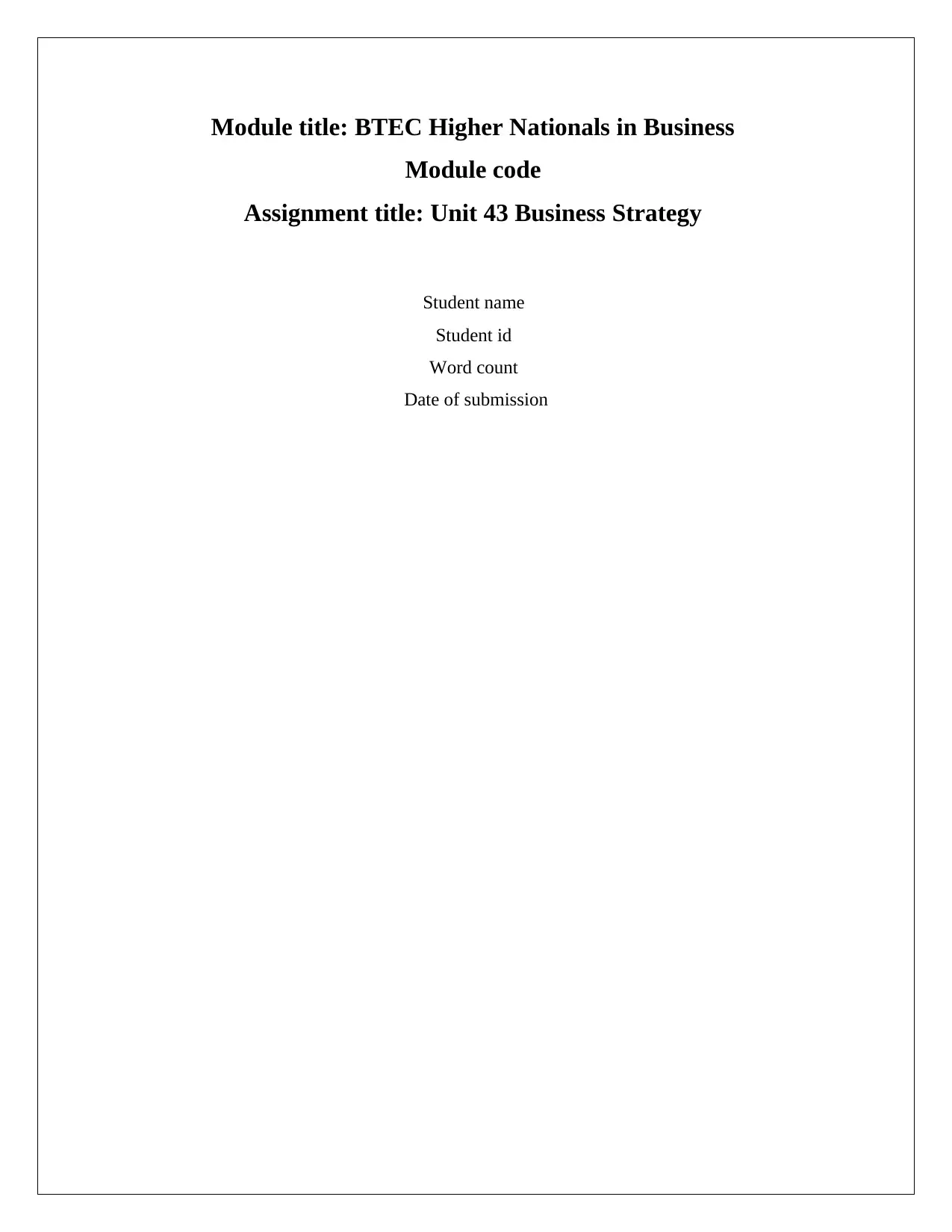
Module title: BTEC Higher Nationals in Business
Module code
Assignment title: Unit 43 Business Strategy
Student name
Student id
Word count
Date of submission
Module code
Assignment title: Unit 43 Business Strategy
Student name
Student id
Word count
Date of submission
Paraphrase This Document
Need a fresh take? Get an instant paraphrase of this document with our AI Paraphraser
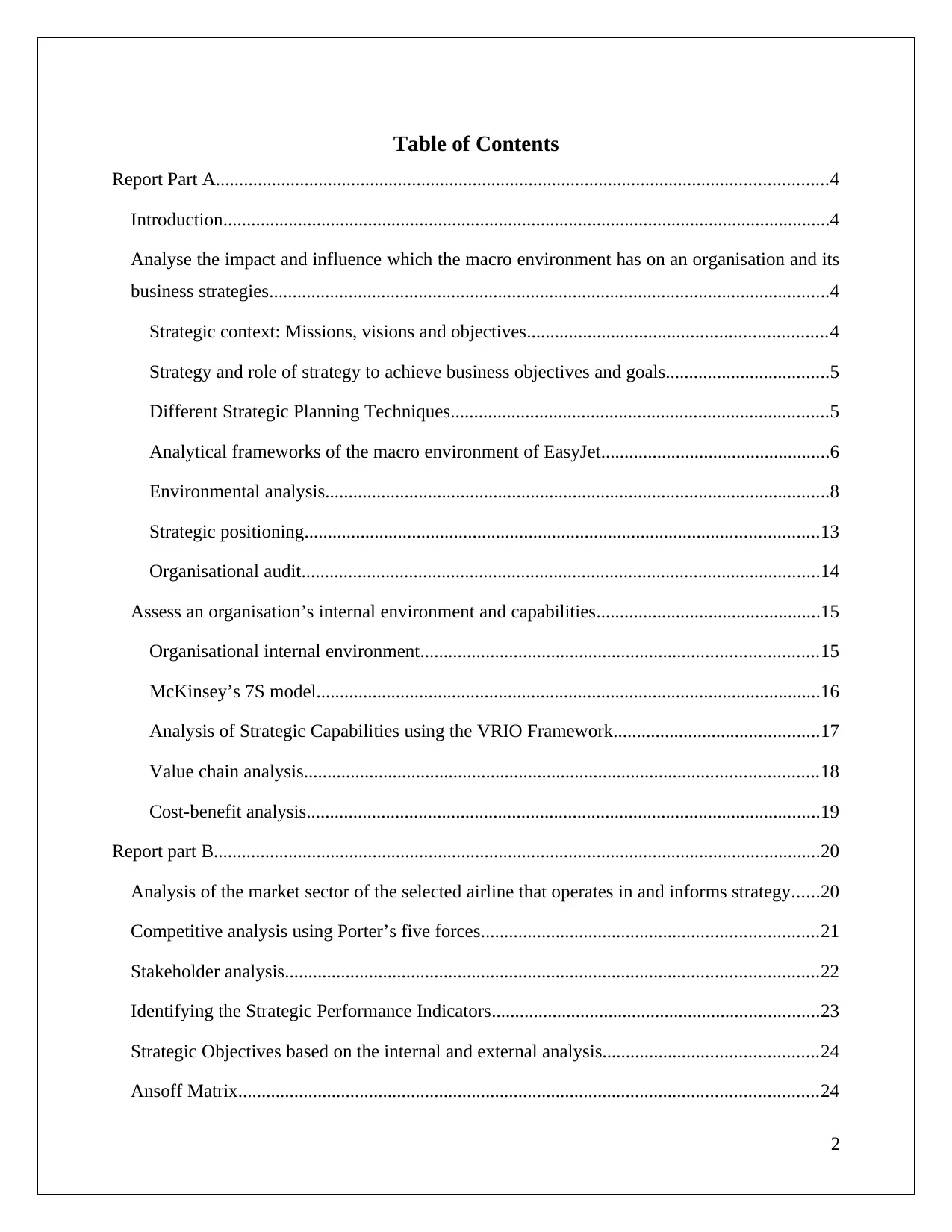
Table of Contents
Report Part A...................................................................................................................................4
Introduction..................................................................................................................................4
Analyse the impact and influence which the macro environment has on an organisation and its
business strategies........................................................................................................................4
Strategic context: Missions, visions and objectives................................................................4
Strategy and role of strategy to achieve business objectives and goals...................................5
Different Strategic Planning Techniques.................................................................................5
Analytical frameworks of the macro environment of EasyJet.................................................6
Environmental analysis............................................................................................................8
Strategic positioning..............................................................................................................13
Organisational audit...............................................................................................................14
Assess an organisation’s internal environment and capabilities................................................15
Organisational internal environment.....................................................................................15
McKinsey’s 7S model............................................................................................................16
Analysis of Strategic Capabilities using the VRIO Framework............................................17
Value chain analysis..............................................................................................................18
Cost-benefit analysis..............................................................................................................19
Report part B..................................................................................................................................20
Analysis of the market sector of the selected airline that operates in and informs strategy......20
Competitive analysis using Porter’s five forces........................................................................21
Stakeholder analysis..................................................................................................................22
Identifying the Strategic Performance Indicators......................................................................23
Strategic Objectives based on the internal and external analysis..............................................24
Ansoff Matrix............................................................................................................................24
2
Report Part A...................................................................................................................................4
Introduction..................................................................................................................................4
Analyse the impact and influence which the macro environment has on an organisation and its
business strategies........................................................................................................................4
Strategic context: Missions, visions and objectives................................................................4
Strategy and role of strategy to achieve business objectives and goals...................................5
Different Strategic Planning Techniques.................................................................................5
Analytical frameworks of the macro environment of EasyJet.................................................6
Environmental analysis............................................................................................................8
Strategic positioning..............................................................................................................13
Organisational audit...............................................................................................................14
Assess an organisation’s internal environment and capabilities................................................15
Organisational internal environment.....................................................................................15
McKinsey’s 7S model............................................................................................................16
Analysis of Strategic Capabilities using the VRIO Framework............................................17
Value chain analysis..............................................................................................................18
Cost-benefit analysis..............................................................................................................19
Report part B..................................................................................................................................20
Analysis of the market sector of the selected airline that operates in and informs strategy......20
Competitive analysis using Porter’s five forces........................................................................21
Stakeholder analysis..................................................................................................................22
Identifying the Strategic Performance Indicators......................................................................23
Strategic Objectives based on the internal and external analysis..............................................24
Ansoff Matrix............................................................................................................................24
2
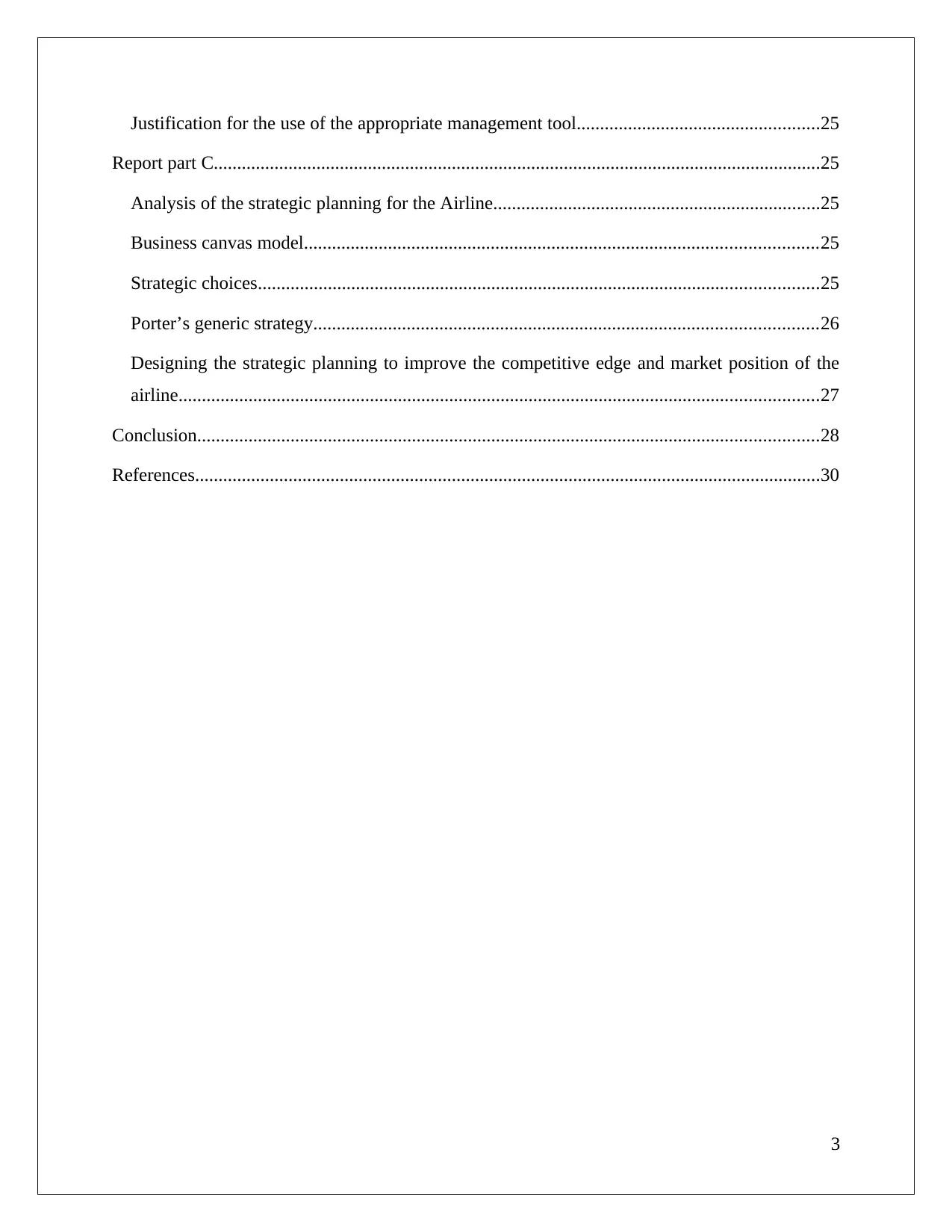
Justification for the use of the appropriate management tool....................................................25
Report part C..................................................................................................................................25
Analysis of the strategic planning for the Airline......................................................................25
Business canvas model..............................................................................................................25
Strategic choices........................................................................................................................25
Porter’s generic strategy............................................................................................................26
Designing the strategic planning to improve the competitive edge and market position of the
airline.........................................................................................................................................27
Conclusion.....................................................................................................................................28
References......................................................................................................................................30
3
Report part C..................................................................................................................................25
Analysis of the strategic planning for the Airline......................................................................25
Business canvas model..............................................................................................................25
Strategic choices........................................................................................................................25
Porter’s generic strategy............................................................................................................26
Designing the strategic planning to improve the competitive edge and market position of the
airline.........................................................................................................................................27
Conclusion.....................................................................................................................................28
References......................................................................................................................................30
3
⊘ This is a preview!⊘
Do you want full access?
Subscribe today to unlock all pages.

Trusted by 1+ million students worldwide
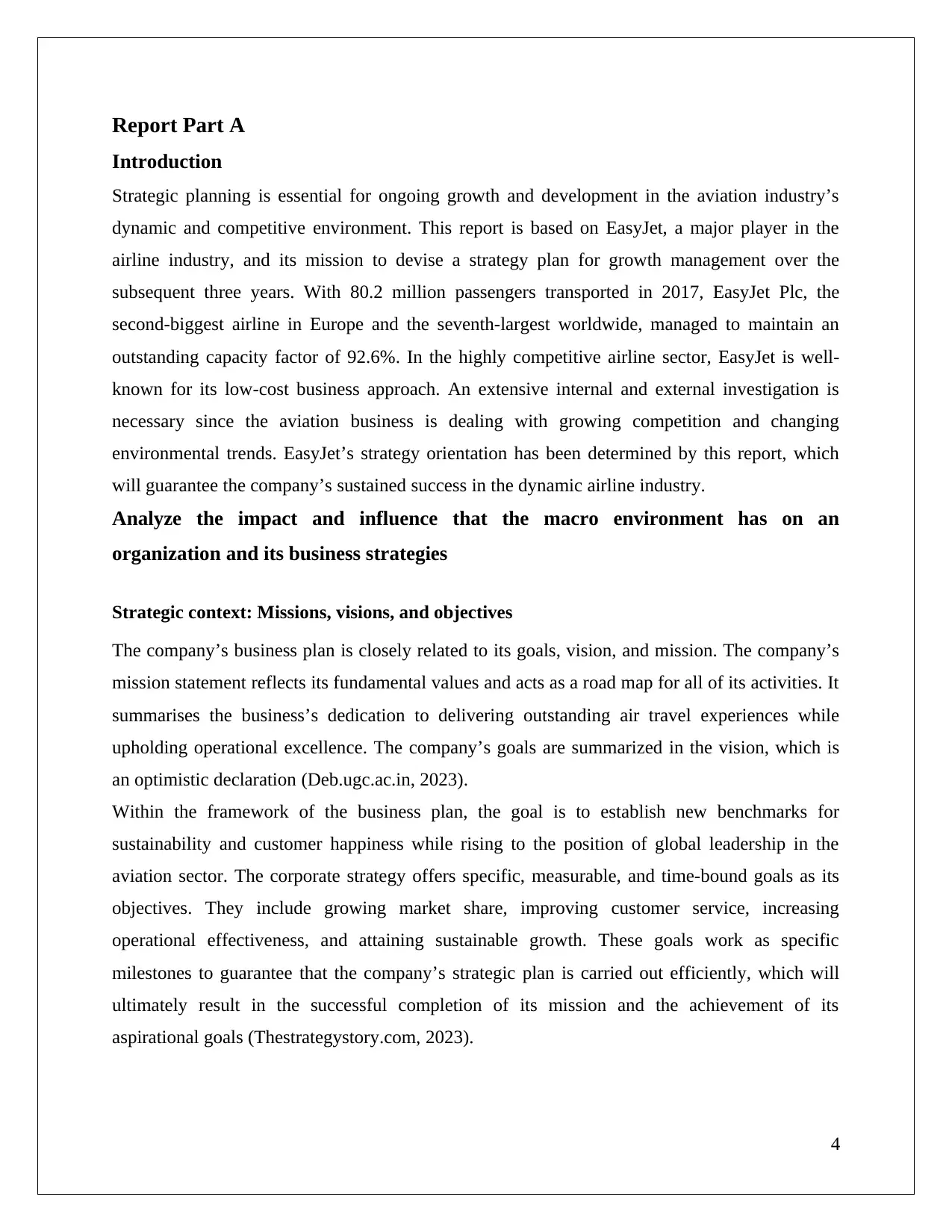
Report Part A
Introduction
Strategic planning is essential for ongoing growth and development in the aviation industry’s
dynamic and competitive environment. This report is based on EasyJet, a major player in the
airline industry, and its mission to devise a strategy plan for growth management over the
subsequent three years. With 80.2 million passengers transported in 2017, EasyJet Plc, the
second-biggest airline in Europe and the seventh-largest worldwide, managed to maintain an
outstanding capacity factor of 92.6%. In the highly competitive airline sector, EasyJet is well-
known for its low-cost business approach. An extensive internal and external investigation is
necessary since the aviation business is dealing with growing competition and changing
environmental trends. EasyJet’s strategy orientation has been determined by this report, which
will guarantee the company’s sustained success in the dynamic airline industry.
Analyze the impact and influence that the macro environment has on an
organization and its business strategies
Strategic context: Missions, visions, and objectives
The company’s business plan is closely related to its goals, vision, and mission. The company’s
mission statement reflects its fundamental values and acts as a road map for all of its activities. It
summarises the business’s dedication to delivering outstanding air travel experiences while
upholding operational excellence. The company’s goals are summarized in the vision, which is
an optimistic declaration (Deb.ugc.ac.in, 2023).
Within the framework of the business plan, the goal is to establish new benchmarks for
sustainability and customer happiness while rising to the position of global leadership in the
aviation sector. The corporate strategy offers specific, measurable, and time-bound goals as its
objectives. They include growing market share, improving customer service, increasing
operational effectiveness, and attaining sustainable growth. These goals work as specific
milestones to guarantee that the company’s strategic plan is carried out efficiently, which will
ultimately result in the successful completion of its mission and the achievement of its
aspirational goals (Thestrategystory.com, 2023).
4
Introduction
Strategic planning is essential for ongoing growth and development in the aviation industry’s
dynamic and competitive environment. This report is based on EasyJet, a major player in the
airline industry, and its mission to devise a strategy plan for growth management over the
subsequent three years. With 80.2 million passengers transported in 2017, EasyJet Plc, the
second-biggest airline in Europe and the seventh-largest worldwide, managed to maintain an
outstanding capacity factor of 92.6%. In the highly competitive airline sector, EasyJet is well-
known for its low-cost business approach. An extensive internal and external investigation is
necessary since the aviation business is dealing with growing competition and changing
environmental trends. EasyJet’s strategy orientation has been determined by this report, which
will guarantee the company’s sustained success in the dynamic airline industry.
Analyze the impact and influence that the macro environment has on an
organization and its business strategies
Strategic context: Missions, visions, and objectives
The company’s business plan is closely related to its goals, vision, and mission. The company’s
mission statement reflects its fundamental values and acts as a road map for all of its activities. It
summarises the business’s dedication to delivering outstanding air travel experiences while
upholding operational excellence. The company’s goals are summarized in the vision, which is
an optimistic declaration (Deb.ugc.ac.in, 2023).
Within the framework of the business plan, the goal is to establish new benchmarks for
sustainability and customer happiness while rising to the position of global leadership in the
aviation sector. The corporate strategy offers specific, measurable, and time-bound goals as its
objectives. They include growing market share, improving customer service, increasing
operational effectiveness, and attaining sustainable growth. These goals work as specific
milestones to guarantee that the company’s strategic plan is carried out efficiently, which will
ultimately result in the successful completion of its mission and the achievement of its
aspirational goals (Thestrategystory.com, 2023).
4
Paraphrase This Document
Need a fresh take? Get an instant paraphrase of this document with our AI Paraphraser
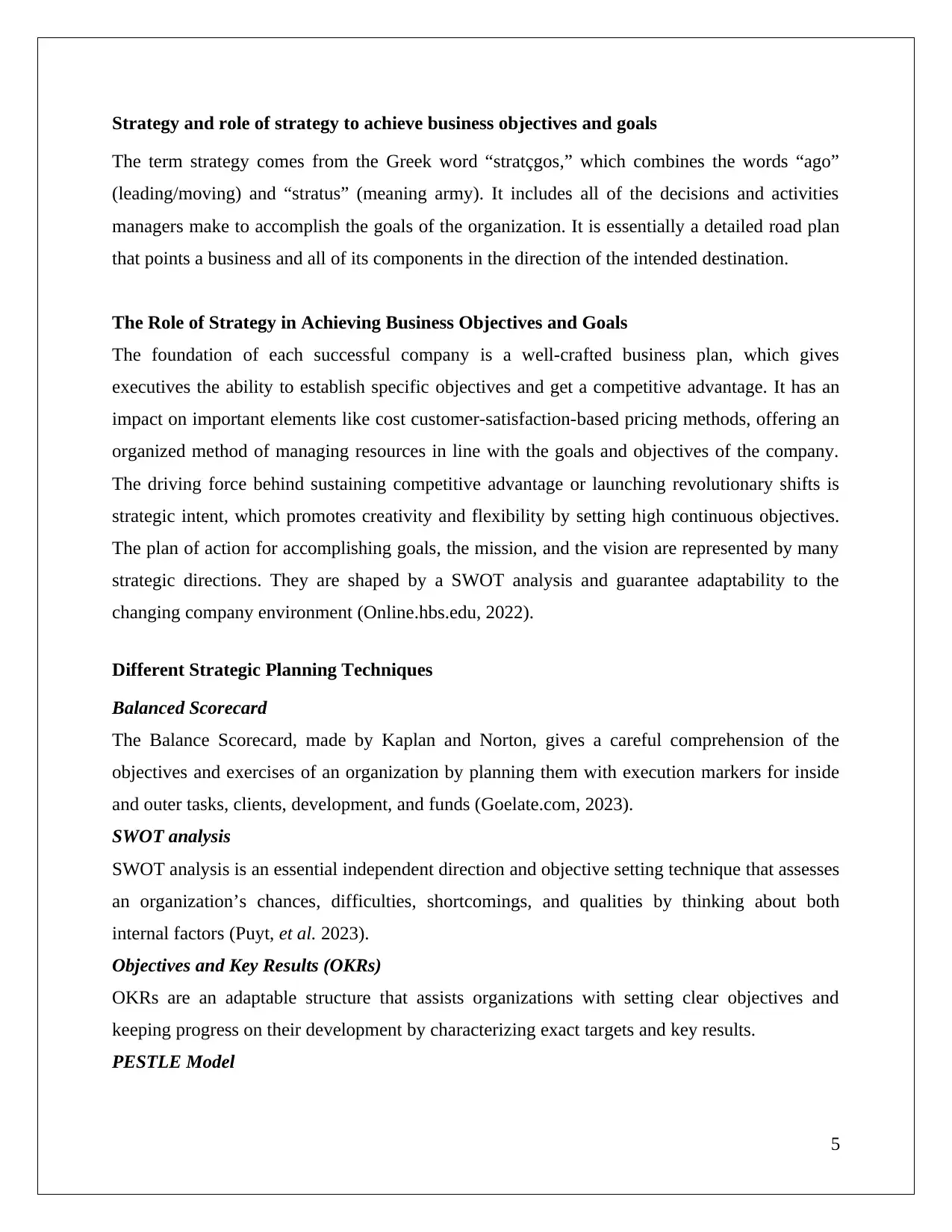
Strategy and role of strategy to achieve business objectives and goals
The term strategy comes from the Greek word “stratçgos,” which combines the words “ago”
(leading/moving) and “stratus” (meaning army). It includes all of the decisions and activities
managers make to accomplish the goals of the organization. It is essentially a detailed road plan
that points a business and all of its components in the direction of the intended destination.
The Role of Strategy in Achieving Business Objectives and Goals
The foundation of each successful company is a well-crafted business plan, which gives
executives the ability to establish specific objectives and get a competitive advantage. It has an
impact on important elements like cost customer-satisfaction-based pricing methods, offering an
organized method of managing resources in line with the goals and objectives of the company.
The driving force behind sustaining competitive advantage or launching revolutionary shifts is
strategic intent, which promotes creativity and flexibility by setting high continuous objectives.
The plan of action for accomplishing goals, the mission, and the vision are represented by many
strategic directions. They are shaped by a SWOT analysis and guarantee adaptability to the
changing company environment (Online.hbs.edu, 2022).
Different Strategic Planning Techniques
Balanced Scorecard
The Balance Scorecard, made by Kaplan and Norton, gives a careful comprehension of the
objectives and exercises of an organization by planning them with execution markers for inside
and outer tasks, clients, development, and funds (Goelate.com, 2023).
SWOT analysis
SWOT analysis is an essential independent direction and objective setting technique that assesses
an organization’s chances, difficulties, shortcomings, and qualities by thinking about both
internal factors (Puyt, et al. 2023).
Objectives and Key Results (OKRs)
OKRs are an adaptable structure that assists organizations with setting clear objectives and
keeping progress on their development by characterizing exact targets and key results.
PESTLE Model
5
The term strategy comes from the Greek word “stratçgos,” which combines the words “ago”
(leading/moving) and “stratus” (meaning army). It includes all of the decisions and activities
managers make to accomplish the goals of the organization. It is essentially a detailed road plan
that points a business and all of its components in the direction of the intended destination.
The Role of Strategy in Achieving Business Objectives and Goals
The foundation of each successful company is a well-crafted business plan, which gives
executives the ability to establish specific objectives and get a competitive advantage. It has an
impact on important elements like cost customer-satisfaction-based pricing methods, offering an
organized method of managing resources in line with the goals and objectives of the company.
The driving force behind sustaining competitive advantage or launching revolutionary shifts is
strategic intent, which promotes creativity and flexibility by setting high continuous objectives.
The plan of action for accomplishing goals, the mission, and the vision are represented by many
strategic directions. They are shaped by a SWOT analysis and guarantee adaptability to the
changing company environment (Online.hbs.edu, 2022).
Different Strategic Planning Techniques
Balanced Scorecard
The Balance Scorecard, made by Kaplan and Norton, gives a careful comprehension of the
objectives and exercises of an organization by planning them with execution markers for inside
and outer tasks, clients, development, and funds (Goelate.com, 2023).
SWOT analysis
SWOT analysis is an essential independent direction and objective setting technique that assesses
an organization’s chances, difficulties, shortcomings, and qualities by thinking about both
internal factors (Puyt, et al. 2023).
Objectives and Key Results (OKRs)
OKRs are an adaptable structure that assists organizations with setting clear objectives and
keeping progress on their development by characterizing exact targets and key results.
PESTLE Model
5
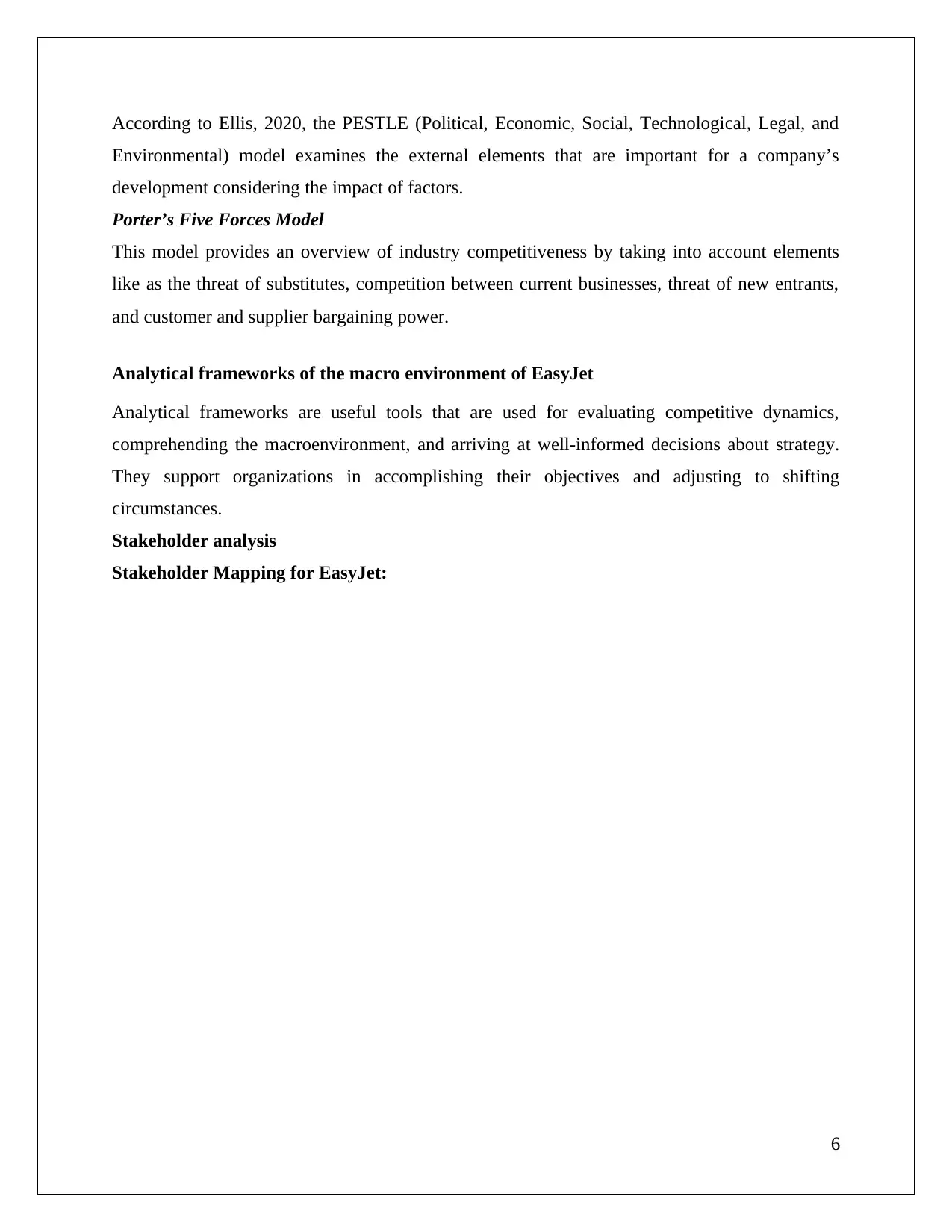
According to Ellis, 2020, the PESTLE (Political, Economic, Social, Technological, Legal, and
Environmental) model examines the external elements that are important for a company’s
development considering the impact of factors.
Porter’s Five Forces Model
This model provides an overview of industry competitiveness by taking into account elements
like as the threat of substitutes, competition between current businesses, threat of new entrants,
and customer and supplier bargaining power.
Analytical frameworks of the macro environment of EasyJet
Analytical frameworks are useful tools that are used for evaluating competitive dynamics,
comprehending the macroenvironment, and arriving at well-informed decisions about strategy.
They support organizations in accomplishing their objectives and adjusting to shifting
circumstances.
Stakeholder analysis
Stakeholder Mapping for EasyJet:
6
Environmental) model examines the external elements that are important for a company’s
development considering the impact of factors.
Porter’s Five Forces Model
This model provides an overview of industry competitiveness by taking into account elements
like as the threat of substitutes, competition between current businesses, threat of new entrants,
and customer and supplier bargaining power.
Analytical frameworks of the macro environment of EasyJet
Analytical frameworks are useful tools that are used for evaluating competitive dynamics,
comprehending the macroenvironment, and arriving at well-informed decisions about strategy.
They support organizations in accomplishing their objectives and adjusting to shifting
circumstances.
Stakeholder analysis
Stakeholder Mapping for EasyJet:
6
⊘ This is a preview!⊘
Do you want full access?
Subscribe today to unlock all pages.

Trusted by 1+ million students worldwide
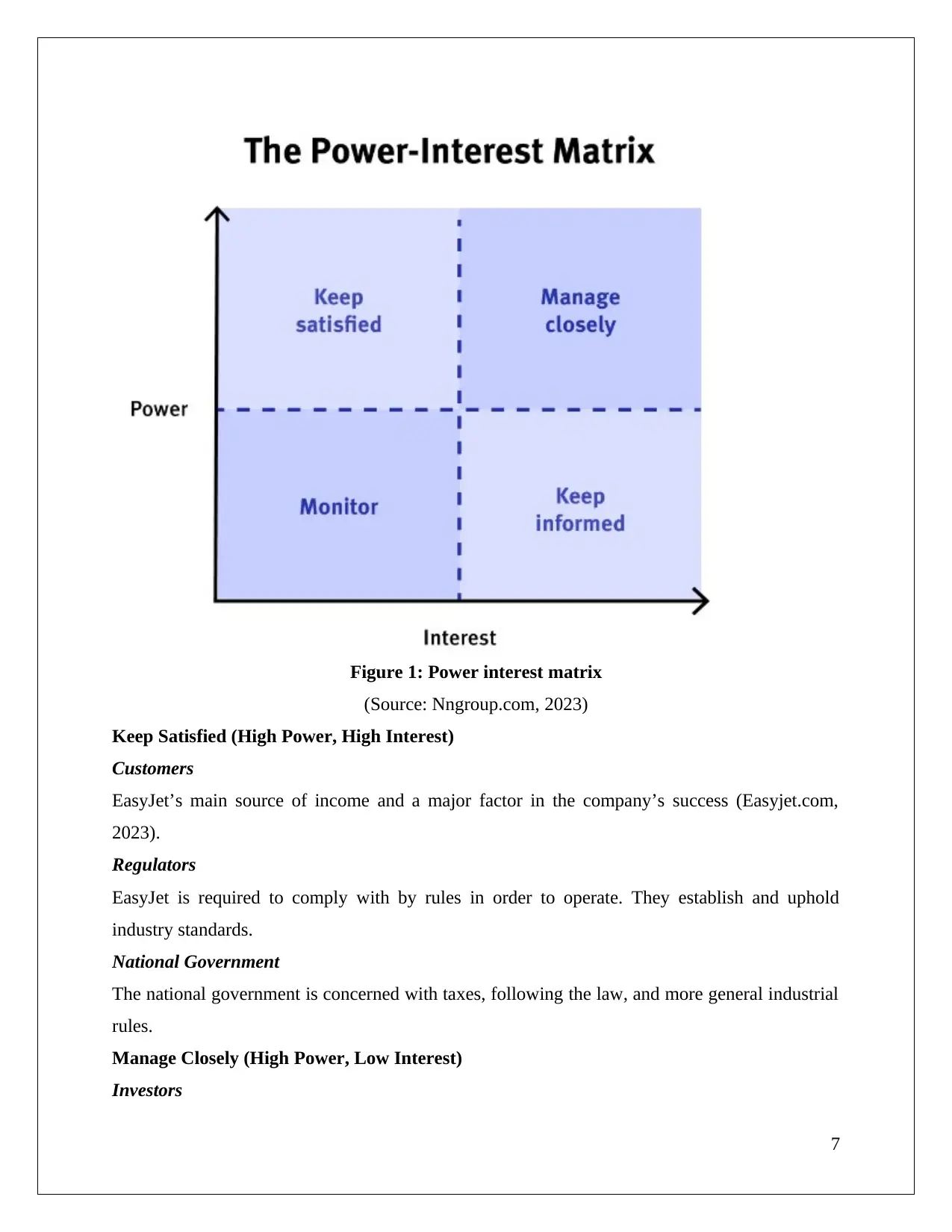
Figure 1: Power interest matrix
(Source: Nngroup.com, 2023)
Keep Satisfied (High Power, High Interest)
Customers
EasyJet’s main source of income and a major factor in the company’s success (Easyjet.com,
2023).
Regulators
EasyJet is required to comply with by rules in order to operate. They establish and uphold
industry standards.
National Government
The national government is concerned with taxes, following the law, and more general industrial
rules.
Manage Closely (High Power, Low Interest)
Investors
7
(Source: Nngroup.com, 2023)
Keep Satisfied (High Power, High Interest)
Customers
EasyJet’s main source of income and a major factor in the company’s success (Easyjet.com,
2023).
Regulators
EasyJet is required to comply with by rules in order to operate. They establish and uphold
industry standards.
National Government
The national government is concerned with taxes, following the law, and more general industrial
rules.
Manage Closely (High Power, Low Interest)
Investors
7
Paraphrase This Document
Need a fresh take? Get an instant paraphrase of this document with our AI Paraphraser
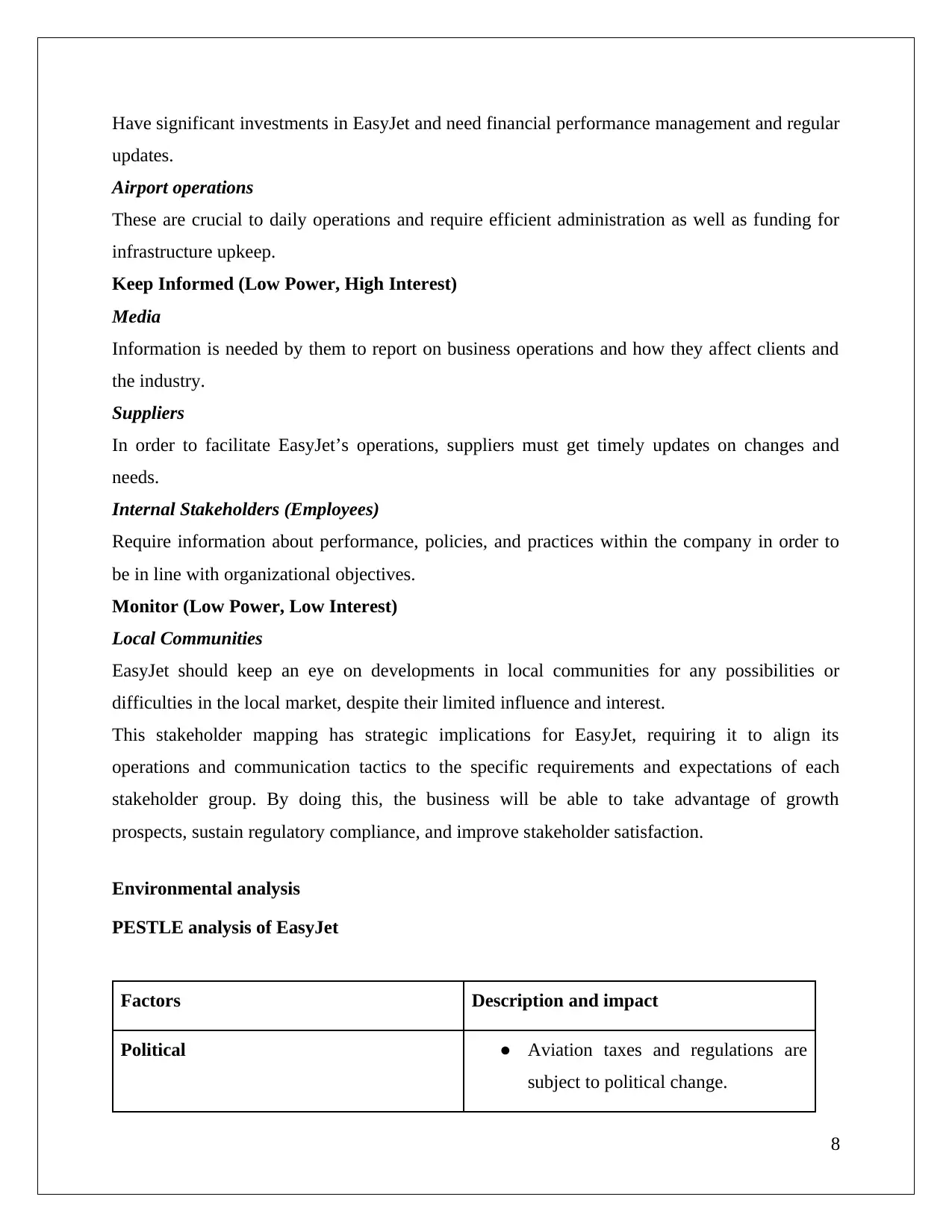
Have significant investments in EasyJet and need financial performance management and regular
updates.
Airport operations
These are crucial to daily operations and require efficient administration as well as funding for
infrastructure upkeep.
Keep Informed (Low Power, High Interest)
Media
Information is needed by them to report on business operations and how they affect clients and
the industry.
Suppliers
In order to facilitate EasyJet’s operations, suppliers must get timely updates on changes and
needs.
Internal Stakeholders (Employees)
Require information about performance, policies, and practices within the company in order to
be in line with organizational objectives.
Monitor (Low Power, Low Interest)
Local Communities
EasyJet should keep an eye on developments in local communities for any possibilities or
difficulties in the local market, despite their limited influence and interest.
This stakeholder mapping has strategic implications for EasyJet, requiring it to align its
operations and communication tactics to the specific requirements and expectations of each
stakeholder group. By doing this, the business will be able to take advantage of growth
prospects, sustain regulatory compliance, and improve stakeholder satisfaction.
Environmental analysis
PESTLE analysis of EasyJet
Factors Description and impact
Political ● Aviation taxes and regulations are
subject to political change.
8
updates.
Airport operations
These are crucial to daily operations and require efficient administration as well as funding for
infrastructure upkeep.
Keep Informed (Low Power, High Interest)
Media
Information is needed by them to report on business operations and how they affect clients and
the industry.
Suppliers
In order to facilitate EasyJet’s operations, suppliers must get timely updates on changes and
needs.
Internal Stakeholders (Employees)
Require information about performance, policies, and practices within the company in order to
be in line with organizational objectives.
Monitor (Low Power, Low Interest)
Local Communities
EasyJet should keep an eye on developments in local communities for any possibilities or
difficulties in the local market, despite their limited influence and interest.
This stakeholder mapping has strategic implications for EasyJet, requiring it to align its
operations and communication tactics to the specific requirements and expectations of each
stakeholder group. By doing this, the business will be able to take advantage of growth
prospects, sustain regulatory compliance, and improve stakeholder satisfaction.
Environmental analysis
PESTLE analysis of EasyJet
Factors Description and impact
Political ● Aviation taxes and regulations are
subject to political change.
8
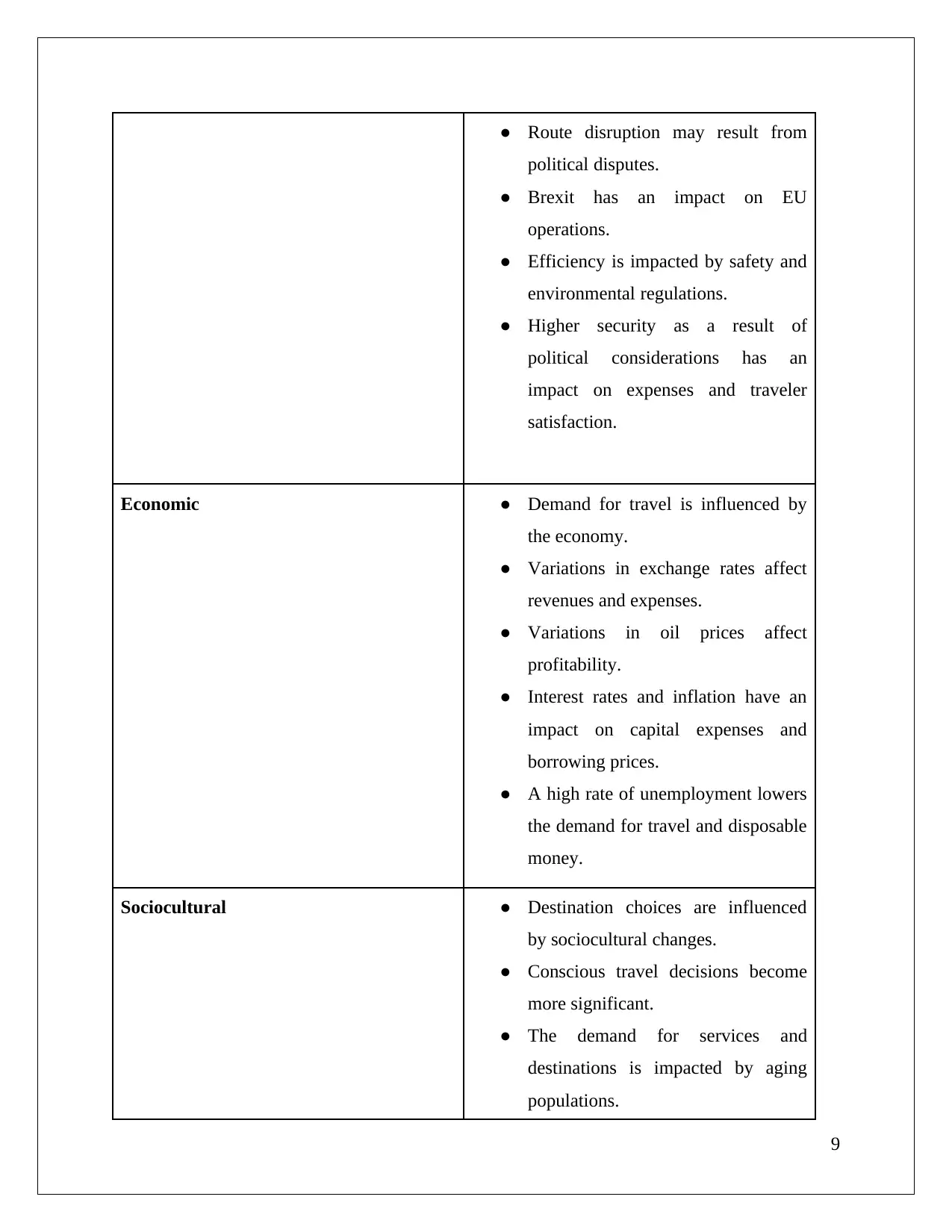
● Route disruption may result from
political disputes.
● Brexit has an impact on EU
operations.
● Efficiency is impacted by safety and
environmental regulations.
● Higher security as a result of
political considerations has an
impact on expenses and traveler
satisfaction.
Economic ● Demand for travel is influenced by
the economy.
● Variations in exchange rates affect
revenues and expenses.
● Variations in oil prices affect
profitability.
● Interest rates and inflation have an
impact on capital expenses and
borrowing prices.
● A high rate of unemployment lowers
the demand for travel and disposable
money.
Sociocultural ● Destination choices are influenced
by sociocultural changes.
● Conscious travel decisions become
more significant.
● The demand for services and
destinations is impacted by aging
populations.
9
political disputes.
● Brexit has an impact on EU
operations.
● Efficiency is impacted by safety and
environmental regulations.
● Higher security as a result of
political considerations has an
impact on expenses and traveler
satisfaction.
Economic ● Demand for travel is influenced by
the economy.
● Variations in exchange rates affect
revenues and expenses.
● Variations in oil prices affect
profitability.
● Interest rates and inflation have an
impact on capital expenses and
borrowing prices.
● A high rate of unemployment lowers
the demand for travel and disposable
money.
Sociocultural ● Destination choices are influenced
by sociocultural changes.
● Conscious travel decisions become
more significant.
● The demand for services and
destinations is impacted by aging
populations.
9
⊘ This is a preview!⊘
Do you want full access?
Subscribe today to unlock all pages.

Trusted by 1+ million students worldwide
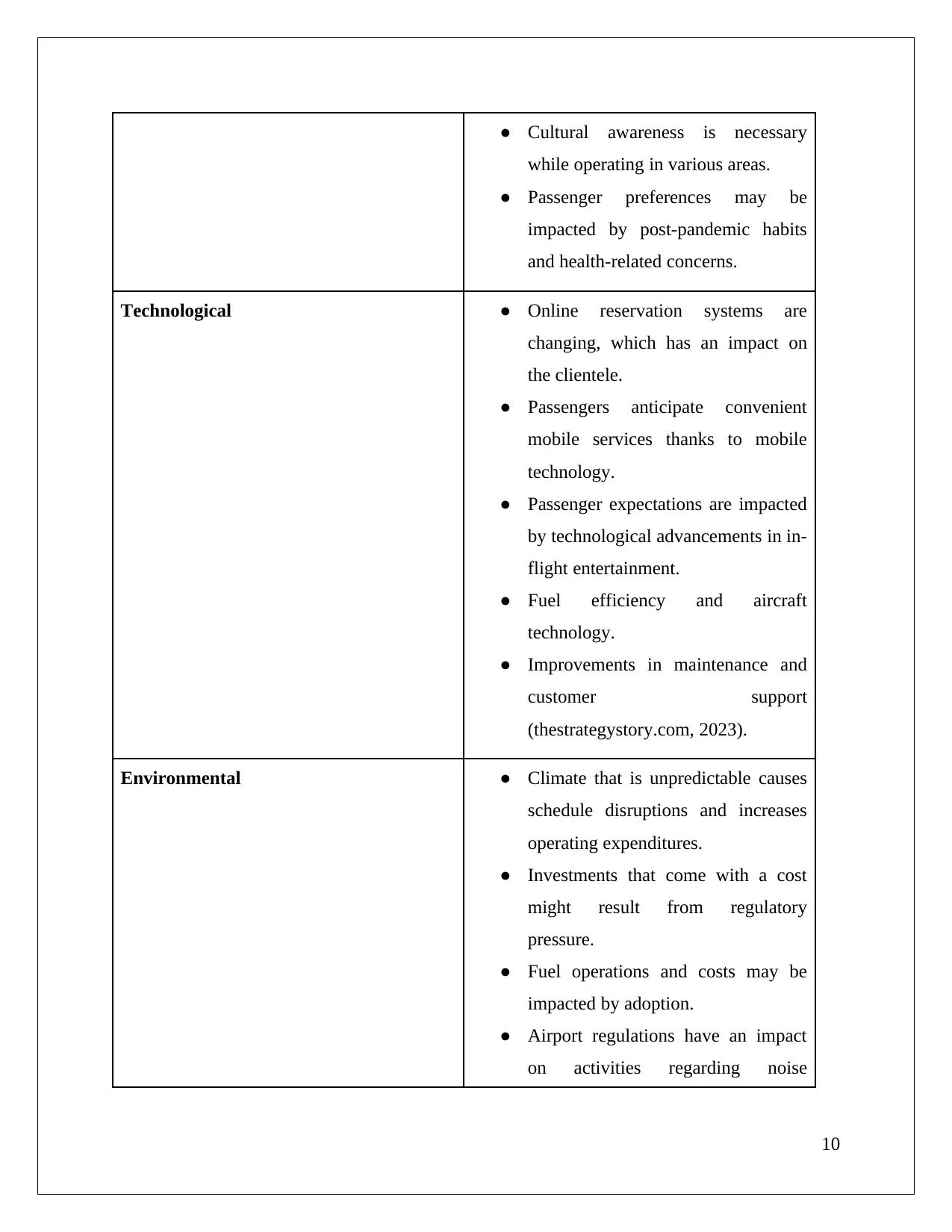
● Cultural awareness is necessary
while operating in various areas.
● Passenger preferences may be
impacted by post-pandemic habits
and health-related concerns.
Technological ● Online reservation systems are
changing, which has an impact on
the clientele.
● Passengers anticipate convenient
mobile services thanks to mobile
technology.
● Passenger expectations are impacted
by technological advancements in in-
flight entertainment.
● Fuel efficiency and aircraft
technology.
● Improvements in maintenance and
customer support
(thestrategystory.com, 2023).
Environmental ● Climate that is unpredictable causes
schedule disruptions and increases
operating expenditures.
● Investments that come with a cost
might result from regulatory
pressure.
● Fuel operations and costs may be
impacted by adoption.
● Airport regulations have an impact
on activities regarding noise
10
while operating in various areas.
● Passenger preferences may be
impacted by post-pandemic habits
and health-related concerns.
Technological ● Online reservation systems are
changing, which has an impact on
the clientele.
● Passengers anticipate convenient
mobile services thanks to mobile
technology.
● Passenger expectations are impacted
by technological advancements in in-
flight entertainment.
● Fuel efficiency and aircraft
technology.
● Improvements in maintenance and
customer support
(thestrategystory.com, 2023).
Environmental ● Climate that is unpredictable causes
schedule disruptions and increases
operating expenditures.
● Investments that come with a cost
might result from regulatory
pressure.
● Fuel operations and costs may be
impacted by adoption.
● Airport regulations have an impact
on activities regarding noise
10
Paraphrase This Document
Need a fresh take? Get an instant paraphrase of this document with our AI Paraphraser
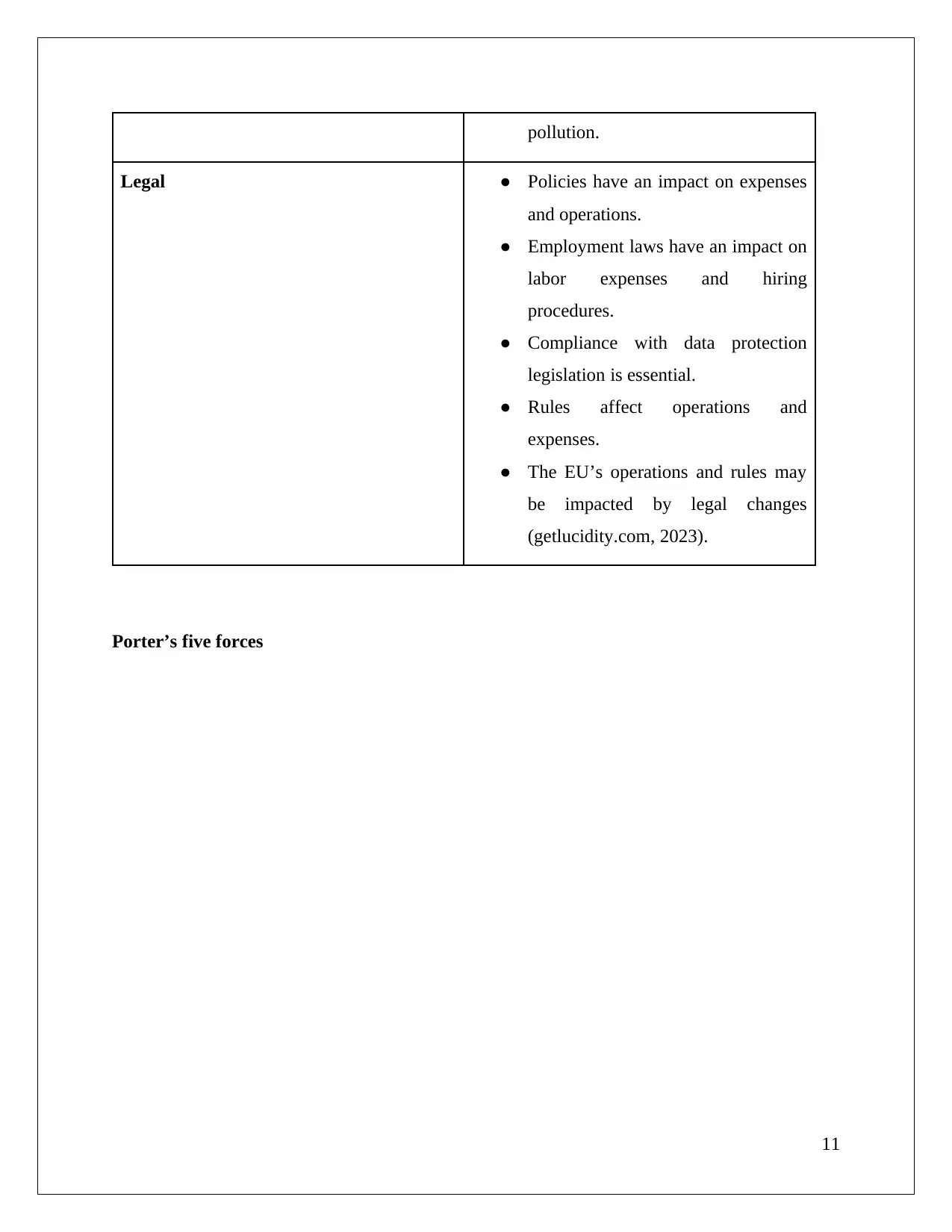
pollution.
Legal ● Policies have an impact on expenses
and operations.
● Employment laws have an impact on
labor expenses and hiring
procedures.
● Compliance with data protection
legislation is essential.
● Rules affect operations and
expenses.
● The EU’s operations and rules may
be impacted by legal changes
(getlucidity.com, 2023).
Porter’s five forces
11
Legal ● Policies have an impact on expenses
and operations.
● Employment laws have an impact on
labor expenses and hiring
procedures.
● Compliance with data protection
legislation is essential.
● Rules affect operations and
expenses.
● The EU’s operations and rules may
be impacted by legal changes
(getlucidity.com, 2023).
Porter’s five forces
11
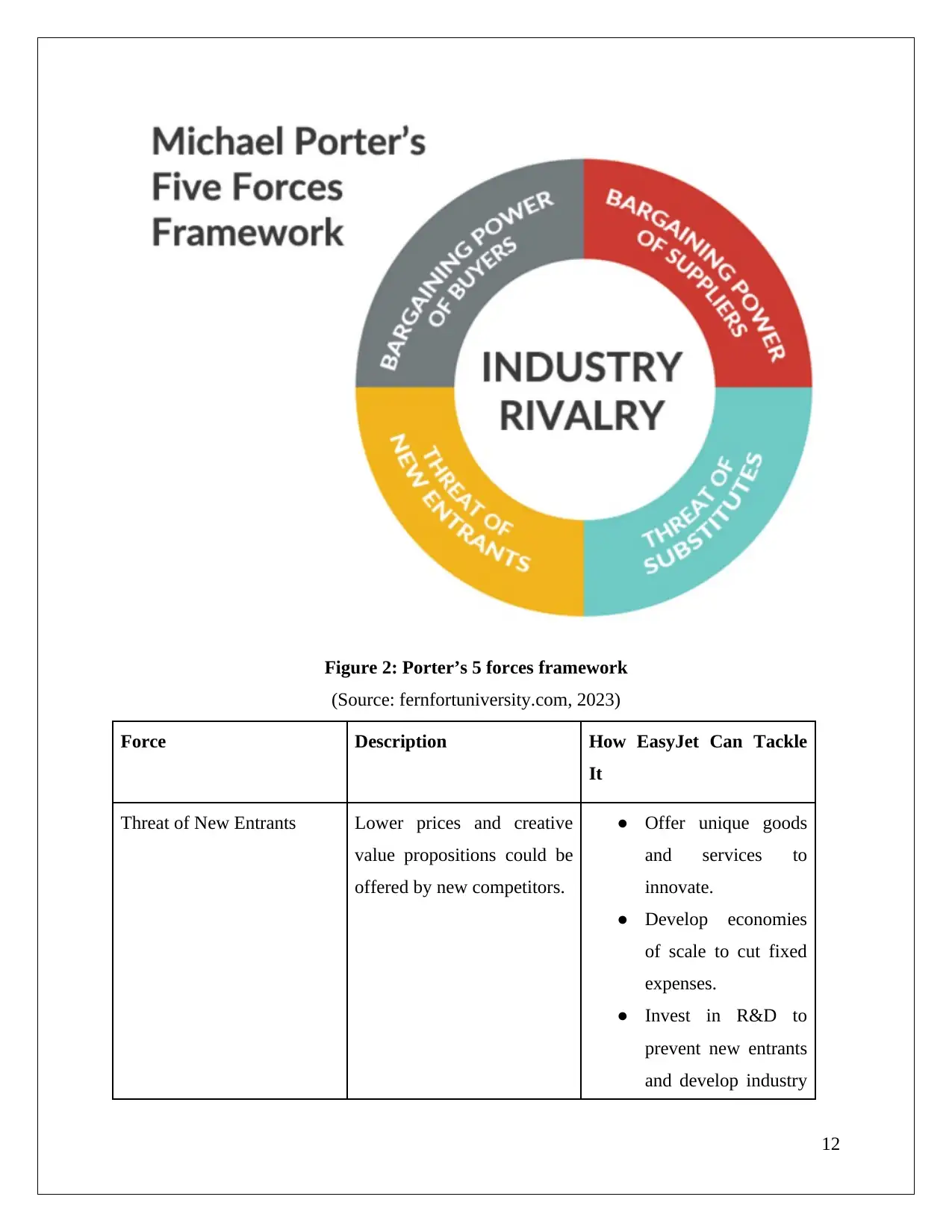
Figure 2: Porter’s 5 forces framework
(Source: fernfortuniversity.com, 2023)
Force Description How EasyJet Can Tackle
It
Threat of New Entrants Lower prices and creative
value propositions could be
offered by new competitors.
● Offer unique goods
and services to
innovate.
● Develop economies
of scale to cut fixed
expenses.
● Invest in R&D to
prevent new entrants
and develop industry
12
(Source: fernfortuniversity.com, 2023)
Force Description How EasyJet Can Tackle
It
Threat of New Entrants Lower prices and creative
value propositions could be
offered by new competitors.
● Offer unique goods
and services to
innovate.
● Develop economies
of scale to cut fixed
expenses.
● Invest in R&D to
prevent new entrants
and develop industry
12
⊘ This is a preview!⊘
Do you want full access?
Subscribe today to unlock all pages.

Trusted by 1+ million students worldwide
1 out of 36
Related Documents
Your All-in-One AI-Powered Toolkit for Academic Success.
+13062052269
info@desklib.com
Available 24*7 on WhatsApp / Email
![[object Object]](/_next/static/media/star-bottom.7253800d.svg)
Unlock your academic potential
Copyright © 2020–2025 A2Z Services. All Rights Reserved. Developed and managed by ZUCOL.



